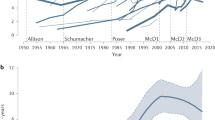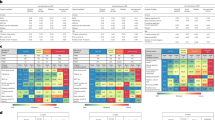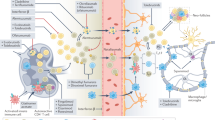Abstract
The latest revision of the McDonald criteria for the diagnosis of multiple sclerosis (MS) was published online in 2017. New features of the criteria, which were designed to facilitate earlier diagnosis of MS, include the recognition of oligoclonal bands in the cerebrospinal fluid as a possible marker of dissemination of MS pathology in time, the introduction of symptomatic lesions as a parameter to demonstrate spatial or temporal pathology dissemination, and the use of cortical lesions to demonstrate dissemination in space. In this Viewpoint, a panel of world-renowned MS specialists share their personal experiences of the new criteria to date.
This is a preview of subscription content, access via your institution
Access options
Access Nature and 54 other Nature Portfolio journals
Get Nature+, our best-value online-access subscription
$32.99 / 30 days
cancel any time
Subscribe to this journal
Receive 12 print issues and online access
$189.00 per year
only $15.75 per issue
Buy this article
- Purchase on SpringerLink
- Instant access to full article PDF
Prices may be subject to local taxes which are calculated during checkout
Similar content being viewed by others
References
Polman, C. H. et al. Diagnostic criteria for multiple sclerosis: 2010 revisions to the McDonald criteria. Ann. Neurol. 69, 292–302 (2011).
Thompson, A. J. et al. Diagnosis of multiple sclerosis: 2017 revisions of the McDonald criteria. Lancet Neurol. 17, 162–173 (2018).
Nelson, F. et al. Improved identification of intracortical lesions in multiple sclerosis with phase-sensitive inversion recovery in combination with fast double inversion recovery MR imaging. AJNR Am. J. Neuroradiol. 28, 1645–1649 (2007).
Kilsdonk, I. D. et al. Increased cortical grey matter lesion detection in multiple sclerosis with 7 T MRI: a post-mortem verification study. Brain 139, 1472–1481 (2016).
van der Vuurst de Vries, R. M. et al. Application of the 2017 revised McDonald criteria for multiple sclerosis to patients with a typical clinically isolated syndrome. JAMA Neurol. 75, 1392–1398 (2018).
Nielsen, A. S. et al. Contribution of cortical lesion subtypes at 7T MRI to physical and cognitive performance in MS. Neurology 81, 641–649 (2013).
Krieger, S. C. & Sumowski, J. New insights into multiple sclerosis clinical course from the topographical model and functional reserve. Neurol. Clin. 36, 13–25 (2018).
Gama, P. D. et al. Study of oligoclonal bands restricted to the cerebrospinal fluid in multiple sclerosis patients in the city of São Paulo. Arq. Neuropsiquiatr. 67, 1017–1022 (2009).
da Gama, P. D. et al. Oligoclonal bands in cerebrospinal fluid of black patients with multiple sclerosis. Biomed. Res. Int. 2015, 217961 (2015).
Fragoso, Y. D. & Brooks, J. B. Encephalomyelitis associated with dengue fever. JAMA Neurol. 73, 1368 (2016).
Frederiksen, J. L. & Topsøe Mailand, M. Vaccines and multiple sclerosis. Acta Neurol. Scand. 136(Suppl. 201), 49–51 (2017).
Larochelle, C., Uphaus, T., Prat, A. & Zipp, F. Secondary progression in multiple sclerosis: neuronal exhaustion or distinct pathology? Trends Neurosci. 39, 325–339 (2016).
Bittner, S. & Zipp, F. AAN unveils new guidelines for MS disease-modifying therapy. Nat. Rev. Neurol. 14, 384–386 (2018).
Leray, E. et al. Evidence for a two-stage disability progression in multiple sclerosis. Brain 133, 1900–1913 (2010).
PRISMS Study Group & The University of British Columbia MS/MRI Analysis Group. PRISMS-4: long-term efficacy of interferon-β-1a in relapsing MS. Neurology 56, 1628–1636 (2001).
University of California, San Francisco MS-EPIC Team. Long-term evolution of multiple sclerosis disability in the treatment era. Ann. Neurol. 80, 499–510 (2016).
Tintore, M. et al. Defining high, medium and low impact prognostic factors for developing multiple sclerosis. Brain 138, 1863–1874 (2015).
Solomon, A. J. et al. The contemporary spectrum of multiple sclerosis misdiagnosis: a multicenter study. Neurology 87, 1393–1399 (2016).
Preziosa, P. et al. Diagnosis of multiple sclerosis: a multicentre study to compare revised McDonald-2010 and Filippi-2010 criteria. J. Neurol. Neurosurg. Psychiatry 89, 316–318 (2018).
Kolber, P. et al. Identification of cortical lesions using DIR and FLAIR in early stages of multiple sclerosis. J. Neurol. 262, 1473–1482 (2015).
Harrison, D. M. et al. Association of cortical lesion burden on 7-T magnetic resonance imaging with cognition and disability in multiple sclerosis. JAMA Neurol. 72, 1004–1012 (2015).
Ellwardt, E. et al. Maladaptive cortical hyperactivity upon recovery from experimental autoimmune encephalomyelitis. Nat. Neurosci. 21, 1392–1403 (2018).
Zipp, F., Gold, R. & Wiendl, H. Identification of inflammatory neuronal injury and prevention of neuronal damage in multiple sclerosis: hope for novel therapies? JAMA Neurol. 70, 1569–1574 (2013).
Siller, N. et al. Serum neurofilament light chain is a biomarker of acute and chronic neuronal damage in early multiple sclerosis. Mult. Scler. 25, 678–686 (2018).
Author information
Authors and Affiliations
Corresponding authors
Ethics declarations
Competing interests
The authors declare no competing interests.
Rights and permissions
About this article
Cite this article
Zipp, F., Oh, J., Fragoso, Y.D. et al. Implementing the 2017 McDonald criteria for the diagnosis of multiple sclerosis. Nat Rev Neurol 15, 441–445 (2019). https://doi.org/10.1038/s41582-019-0194-0
Published:
Issue date:
DOI: https://doi.org/10.1038/s41582-019-0194-0
This article is cited by
-
The incidence and prevalence of crude and familial multiple sclerosis in Tehran, Iran in 2021
Neurological Sciences (2023)
-
Epidemiology of familial multiple sclerosis in Iran: a national registry-based study
BMC Neurology (2022)
-
RNA Sequencing of CD4+ T Cells in Relapsing–Remitting Multiple Sclerosis Patients at Relapse: Deciphering the Involvement of Novel genes and Pathways
Journal of Molecular Neuroscience (2021)
-
Multiple sclerosis therapy consensus group (MSTCG): answers to the discussion questions
Neurological Research and Practice (2021)
-
Multiple Sklerose Therapie Konsensus Gruppe (MSTKG): Positionspapier zur verlaufsmodifizierenden Therapie der Multiplen Sklerose 2021 (White Paper)
Der Nervenarzt (2021)



